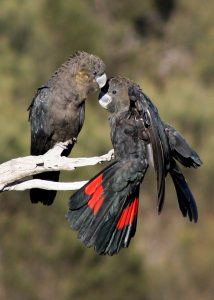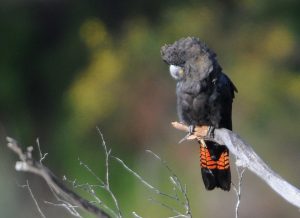
Parrots are under threat around the world for many reasons. Some are directly caused by humans through poaching or habitat destruction. Natural disasters such as hurricanes and fires can also pose serious threats; some might even argue that humans have had a hand in those also.
In our last post, we highlighted the tragic fires that affected the hyacinth macaws of Brazil’s Pantanal. This month, we go to the other side of the world to talk about the beautiful glossy black cockatoos, who are once again at risk because of the horrid 2019-2020 bushfires that ripped through Australia’s Kangaroo Island.
Extinct on mainland Australia, this unique glossy black cockatoo subspecies (Calyptorhynchus lathami halmaturinus) exists only on Kangaroo Island. Because they live in a constrained environment, they have become very specialized eaters, feeding almost exclusively on the seeds of the drooping sheoak (Allocasuarina verticillate) and building nests in very old Eucalyptus evergreen trees.
Glossy black cockatoos are also very slow to reproduce, sometimes laying only one egg per year. Given possible predation from possums, honeybees, and other predatory cockatoos, raising a chick for 90 days to fledging is already very challenging!
Recovery Efforts Offer Hope
The Nature Foundation began its important recovery effort in 1995, when there were less than 160 individual glossies remaining on Kangaroo Island. These cockatoos were later classified as endangered under Australia’s Environment Protection and Biodiversity Conservation Act of 1999. However, the recovery program was considered highly successful – with a steady increase in population, nest protection measures, and an expanded range for feeding and nesting. Then came the fires.

Unfortunately, over 50% or their sheoak feeding habitat may have been destroyed, and at least 35% of their known nests, mostly along the north coast. Without the prior conservation efforts to expand the glossies range and resources, their future may have been in serious jeopardy once again. But there is good news, 454 glossies were counted after the fires, showing more resilience than expected! However, it is essential to continue increasing the range and resources of this rare and special cockatoo. Without our help, they could be only one more fire away from another major loss.
Lafeber’s $500 GLOBAL PARROT conservation grant this month goes to the Nature Foundation to help propagate the sheoaks, increase nesting options, and protect nests from predation. You can also help! To make a tax-deductible donation go to https://www.naturefoundation.org.au/how-to-help/donate/glossy-black-cockatoo-recovery-program and choose the Glossy Black Cockatoo Recovery option.
